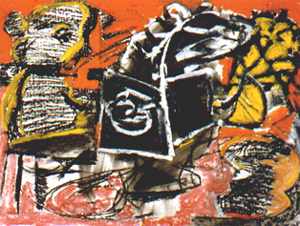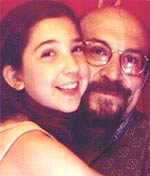BAFA © 2010. All material here is copyrighted. See conditions above. |
David Taylor
painter, aesthetics, art history, U.S.A.
|
My primary commitment as an artist is to painting. I also make drawings with graphite on large sheets of paper. I like to see what I can do with simple media, wrestling with spaces made of marks.
|
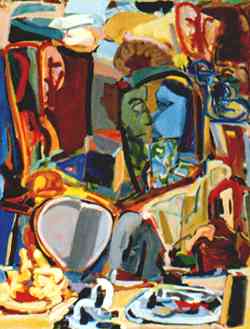
Romance, 1993, oil on canvas.
|
My imagery is also simple, although it may pile up in dense accumulations and deliberately courts several kinds of ambiguity. I like suggestion. I like to see one thing become another. I get a lot from free association and memory as well as direct observation.
I paint because the rhythms and colors and traces of movement recorded by the brush as it constructs fictive spaces and fictive creatures and forms have a visceral impact that is both deeply sensual and deeply meaningful to me.
Every mark, every configuration, every object is haunted by a rich past. Piero Della Francesca, Goya, Valazquez, Titian, Rembrandt, Manet, Cezanne, Soutine, Matisse, Picasso, Gorky, Willem De Kooning, Philip Guston, Max Beckman - there are many others that I look at and remember, and are important to me. These painters exemplify for me the range and the depth of Western Painting.
In art school a friend said to me, "What do you need religion for? You’re a painter!" He meant that painting is itself a religion.
|
For the last few years I have been living with ghosts. Works in the "Rising" series of paintings present a single figure, with body embedded in the earth but head pulling free and radiating upward, eyes wide and staring, a ghost rising up. Arms may be vestigial or not be present at all. The body is often a circle, often divided in half with a red or grey heart. Feet are frequently sticking up, sometimes with clunky shoes and pants. There is a landscape, often but not always desolate, and some kind of grave marker which may resemble a stone or a pyramid or sometimes a bell (although the head is itself reminiscent of a tombstone).
For me this is our everyday experience of upheaval and partial awakening in wonder and embarrassment. It is a celebration of mystery in modern life. It is also a picture of conflict between body and soul, of vulnerability and humiliation and yearning and fear. The transformations my figures experience are the transformations I am going through myself and the transformations I see going on all around. The ghost image of "Rising" carries for me associations of isolation and bewilderment in an existential situation on the one hand and participation in "the Last Judgement" on the other....
...As a Bahá'í I would not attempt to present God as a character on a canvas, so I have to rethink the theme if I’m going to use it. |

"Rising (2)", 1998
oil on canvas
|
The situation of the Final Day which is also the First Day seems to be the situation we all find ourselves in, one way or another. The times are apocalyptic, though the outcome seems less clear than it did in the old pictures with Jesus floating in the air and the saved rising on one side and the sinners sinking on the other. It seems we are all awakening and we are all still asleep. There are so many aspects of awakening and new awareness which we all experience partially. We face the shock of growing awareness again and again. Through this analogy, this semi-abstract painted cartoon, I can touch on my own sense of conflict, of love, of mourning and hope, without limiting myself to some artificial division between the sacred and the profane or between what is difficult and what is uplifting.
|

Rising (5), 1998, 40 x 30 inches,
oil on canvas.
|
The degree of abstraction in the image and the variations it allows give me a range of expressive choices that allow me to say what is important and leave obscure what I want to be obscure. The work is about struggle, about the creative tension that comes with confusion and awkwardness and embarrassment. The work is about facing death. The work is tremendously personal. Too intimate to speak about openly without distortion.
Painting is for me a beautiful way to make my confessions and at the same time keep my secrets. Paint suggests. It does not declare. In a painting nothing is fact but everything is analogy. Faith is there, and everything that is difficult about faith is there also.
I see sex and death and rebirth embedded ambiguously in everyday life as shadow presences. They demand an abstract and elusive treatment but also a kind of familiarity -a mixture of awe and low comedy. That’s what I go for. I try to avoid too much sweetness. I am interested in the spirituality that lurks in flesh and blood. As I pursue these images, other images begin to approach. Paths open. Lately I have been thinking about going to the shopping mall to draw. Maybe that is why I like oil paint so much. Maybe that is why I like semi-abstract art.
|
I have been at this more than thirty years. With all the confusion, all the lost years, it is still a long time. My grandmother, who lived in Boston, painted flowers in water color and oil and copied Renoirs at the Museum of Fine Arts. She left me her brushes and her art books.
I have always lived on the American East Coast, in large cities or near them, and I have always had access to books on art and art instruction and, most important, to great museums, places that I early adopted as my own.
In my teens I lived in Washington, D.C., a ten minute walk from the National Gallery of Art, six hundred years of Western art displayed in mammoth rooms. I spent hundreds of hours there. I would also often walk to the Freer Collection, a great repository of Eastern art, from Persian miniatures and Hindu sculpture to paintings and prints and lacquer and other objects from China and Japan and I would take the bus to the Philips Collection, with its Rothkos, its Matisses and Bonnards and Braques and Cezannes and Klees and John Marins and Arthur Doves.
| 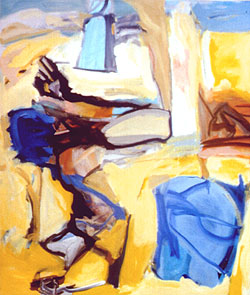
Rising (10), 1997, 62 x 54 inches, oil on canvas.
|

Rising (22), 1998, 42 x 30 inches,
pencil on paper.
|
Of course I also sought out contemporary art. I liked Pop art right off the bat and I still do. Warhol, Lichtenstein, Peter Saul, James Rosenquist, Jasper Johns, Larry Rivers, Richard Hamilton, R.B. Kitaj. Like Mark Tobey I also got jazzed by the chaotic neon on city streets. And by advertising, by magazines, by movies. I still do. I keep my eyes open. I like whatever makes my eyes dance.
I always wanted more of everything. More dancing and more philosophy. More religion and rock ‘n’ roll. I heard about the Bahá'í Faith from Jalaliyyih Quinn, my eighth grade art teacher.
I heard in her telling something I had heard in my heart listening to rock ‘n’ roll on the phonograph one magic afternoon, and so I joined. That was 1968. I am still a Bahá'í and I am still listening to "Turn! Turn! Turn!," the song by the Byrds that grabbed me.
I am still listening to "Blonde on Blonde." I still love Bob Dylan’s voice and his singing. The first serious writing about art I read was rock ‘n’ roll criticism in little magazines devoted to rock as art.
|
...I started out in high school trying to fill a page with motion, constructing drawings like collages to leading the eye around as much as I could manage. I wanted to make a page as complicated as possible. I wanted to make the eyes dance. I used words and phrases to lead the eye around at first. Later I used color and little squiggles...
I was going to revolutionize abstraction, I thought. Looking for the ultimate all-over composition, I made a series of tondos in acrylic on canvas, beginning with one entitled "His First Good Song of Approach to the Rising Sun." (I was a fifteen year old idealist) As I sought consistency, brightly colored calligraphic forms gradually dissolved into mushy blurs in a light brown soup. I knew I would have to start over. And I knew writing all over the surface was not for me.
|
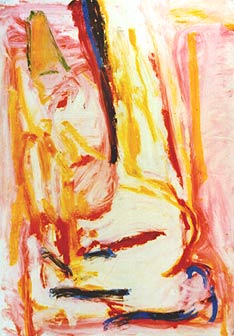
Rising (23), 1998, oil on canvas.
|
By that time I had seen a lot of Mark Tobey’s work. Arthur Dahl Jr. showed me his extensive collection of Tobey slides and I saw the Tobey retrospective held at the Smithsonian in 1974. Appreciating Tobey’s gentle textures, his quiet "art informel." I saw also that his way was not mine. I knew I would have to start over. I would not be looking to the East but to the West.
I went to the Maryland Institute College of Art to pursue objects and figures in space. Three years of art school in Baltimore and two in New York, at the New York Studio School gave me more than a BFA and some technique. It gave me an immersion in a rich if wandering culture, a living conversation that has roots in the workshops of renaissance Italy and the cafes and salons of 19th and 20th Century Paris and the all-night cafeterias and studios and bars of New York. I experienced modern life with its stress and paradox and ferocious beauty.
I came to Connecticut to rest. I quit everything for a while. I got married and divorced, ending up a single father with two kids at home. I went back to the Faith and went back to painting. I went to graduate school at the University of Hartford chiefly as a way to re-enter the community of artists. Since earning my MFA in 1994 I have been painting and showing in Central Connecticut.
|
All this time I have been looking at the work of Bahá'ís who are artists and reading what Bahá'ís write and joining in the art talk. Being part of this community I try to make myself useful. Sometimes I lean against the prevailing winds. I don’t set out to be difficult. I just want to make the sort of work I like, the paintings I want to see. I don’t try to make "universal" art. I look to the West. I call attention when I can to the beauty and the spirit lurking in Expressionist art, in Surrealism, in Pop, in the less idealizing Abstract Expressionists, such as Willem De Kooning and Franz Kline and Jackson Pollock. I don’t see myself as a visionary working in isolation. I see myself as part of a continuing culture.
Excerpts from pages 13 - 15, Arts Dialogue, February 2001.
. . . . . . . . . . . . . . . . . . . . . . . . . . . .
See more of his work at: www.xenarts.com/artists/dtaylor
Email: davidtaylor@attbi.com
As for "SoulTrain," what can I say? It's a rather simple illustration of a
rather personal moment.... a pink engine attains a rickety bridge and makes
its way into a much-desired and desiring but difficult to open tunnel, an
opening in heaven, to everyone's mutual satisfaction...
|
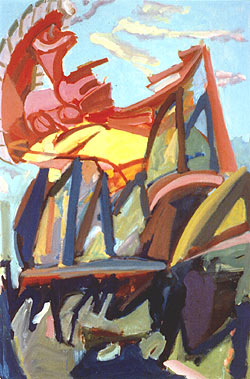
Soul Train, 1994, 48 x 64 inches, oil on canvas. |

Untitled, graphite on paper, 1997, 40 x 42 cm,
by Dave Taylor, U.S.A.
I like to see what I can do with simple media, wrestling with spaces made of marks. My imagery is simple, although it may pile up in dense accumulations and deliberately courts several kinds of ambiguity. |
Article: Expressions of Gender and the Divine
When writing or speaking, the general idea is to use language that will not itself be a barrier between one´s audience and the ideas one wishes to share. Using tone and terminology, one presents an image of
oneself and one´s audience that should be appropriate - not too distant or too familiar. The right balance
always depends on the occasion and the relationship between speaker and listener or the writer and reader.
Language both establishes and maintains relationships. Thus, the appropriate tone and the appropriate language
depend on the relationship between the writer or speaker and his or her audience...
Excerpt from Arts Dialogue, March 1999, page 14 |
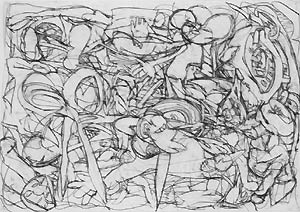
Graphite on paper, 1997, 40 x 42 cm, by Dave Taylor, U.S.A.
|

Graphite on paper, 1997, 40 x 42 cm, by Dave Taylor, U.S.A.
|
- Artist Profile, Arts Dialogue, February 2001
- Painting: Jack on the box, Arts Dialogue, December 1999
- Article: Expressions of Gender and the Divine, Arts Dialogue, March 1999
- Illustration: Painting, Vacuum and Fire, Arts Dialogue, March, 1998
- Letter: Nudity in Art, Arts Dialogue, March 1998
- Review: Ross Woodman on Don Otto Rogers, Arts Dialogue, March 1997
- Letter: comments on Bahá´í arts compilations, Arts Dialogue, September 1996
- Illustration: oil on canvas, Soul Train, Arts Dialogue, September 1996
- Illustration: Arts Dialogue, March, 1996
- Illustration: oil on canvas, Dyptych, Arts Dialogue, December 1995
|

Arts Dialogue, Dintel 20, NL 7333 MC, Apeldoorn, The Netherlands
email: bafa@bahai-library.com
|
|
